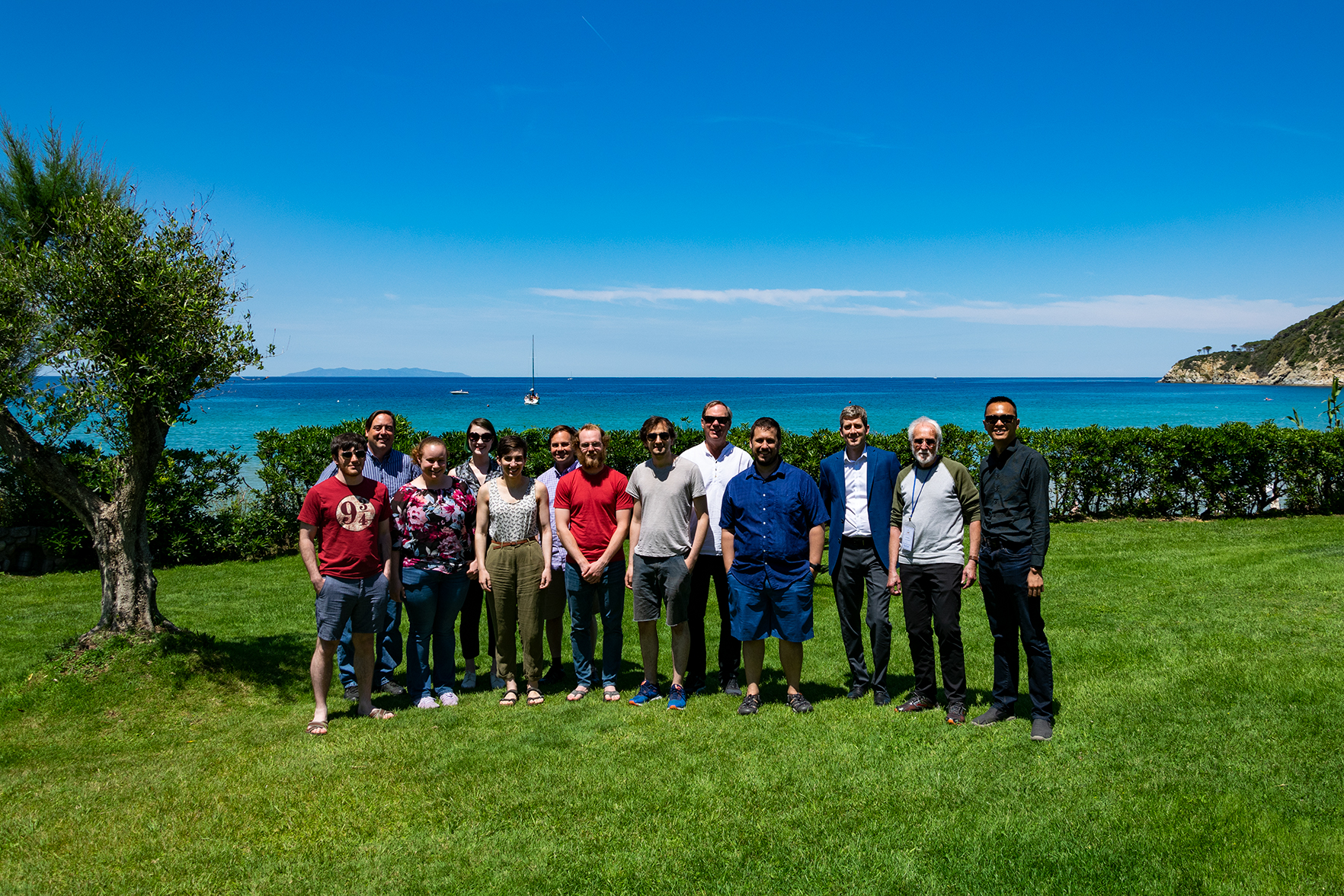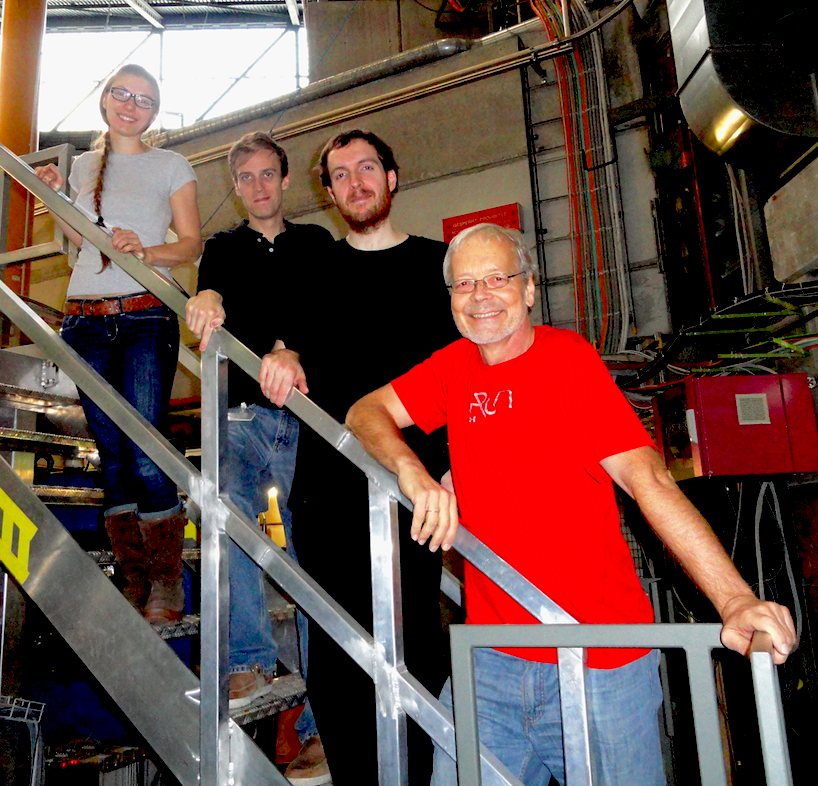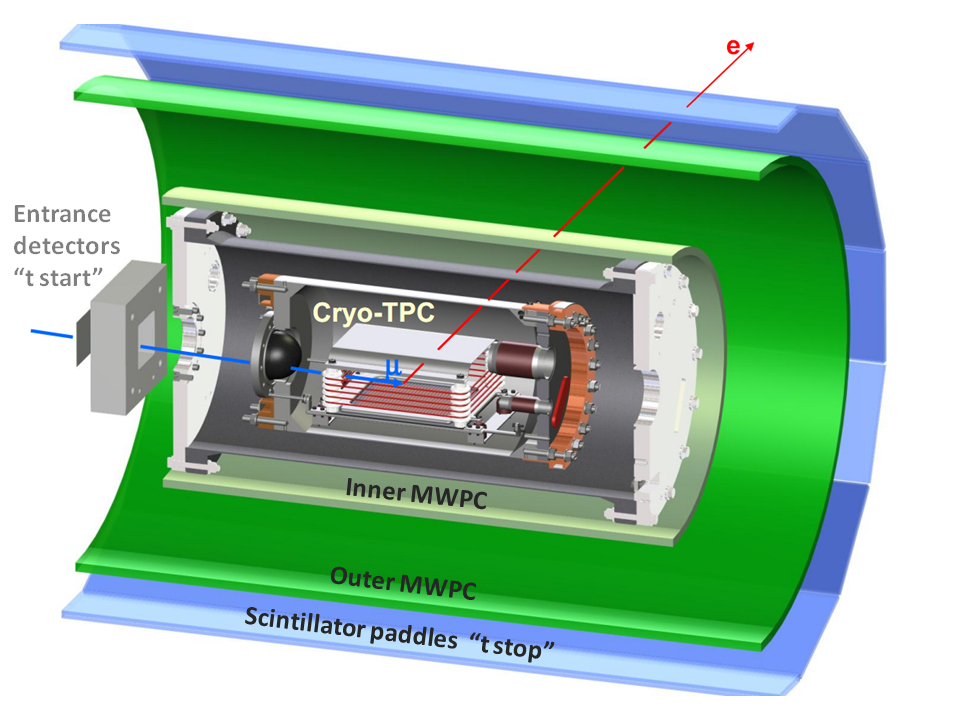Welcome to the Precision Muon Physics Group
at the University of Washington
Muon g-2 Final Results
The Muon g-2 experiment has just released its final results, bringing the precision on the world average value to 124 parts-per-billion. More information on these results can be found in a forthcoming PRL publication and in articles published just after the release. More about the UW Muon Physics Groups' contributions to the experiment can be found below.
Introduction
The Precision Muon Physics Group joined CENPA in 2010. Our mission is to identify compelling, precision experiments that either determine fundamental quantities in physics or sensitively test the Standard Model. Students and postdocs in our group take on leading roles in hardware design and development, all operational aspects of running a complex beam experiment, Monte Carlo simulation, data analysis, and presentation. As a rule, we work collectively on all experiments, but each group member has a specific main focus.
Scientific Motivation
Defining the parameters of the (new) Standard Model (SM) is a high priority of both particle and nuclear physicists. Important advances come from efforts to produce high-mass particles at colliders and symbiotically from precision low-energy measurements. These techniques give a glimpse into the fundamental nature of the SM. The exciting LHC discovery of the Higgs boson with mass 125 GeV/c2 helped stimulate the next generation of study. Truly understanding the fundamental physics and establishing model parameters will require data from a host of complementary precision measurements. Among these are neutrino mixing-angle and mass measurements (other CENPA expertise!), and the search for neutrinoless double beta decay (again, CENPA experts). They include high-precision comparisons of SM predictions with measurement, such as the muon’s anomalous magnetic moment, or the running of the weak mixing angle. Technological and facility advances will allow great strides forward in high-sensitivity searches for the permanent electric dipole moments of the neutron, electron, and certain atoms (UW leading effort); in select rare kaon decays; and in charged lepton flavor violation tests for muons and taus. Collectively, these low-energy precision experiments are part of the New Standard Model Initiative as prioritized in the 2007 Long Range Plan for Nuclear Science, and endorsed in the 2015 and 2023 Long Range Plans. They are, in general, interdisciplinary efforts where nuclear physicists either lead or work in close partnership with high-energy and atomic physicists at a variety of facilities worldwide.
Selected Publications
Physics Articles
Measurement of the Positive Muon Anomalous Magnetic Moment to 127 ppb (Muon g-2, 2025)
Detailed report on the measurement of the positive muon anomalous magnetic moment to 0.20 ppm (Muon g-2, 2024)
Measurement of the Positive Muon Anomalous Magnetic Moment to 0.20 ppm (Muon g-2, 2023)
Measurement of the Positive Muon Anomalous Magnetic Moment to 0.46 ppm (Muon g-2, 2021)
Magnetic-field measurement and analysis for the Muon g-2 Experiment at Fermilab (Muon g-2, 2021)
Beam dynamics corrections to the Run-1 measurement of the muon anomalous magnetic moment at Fermilab (Muon g-2, 2021)
Measurement of the Formation Rate of Muonic Hydrogen Molecules (MuCap, 2015)
Technical Publications
Measurements of a LYSO crystal array from threshold to 100 MeV (PIONEER, 2025)
The fixed probe storage ring magnetometer for the Muon g-2 experiment at Fermi National Accelerator Laboratory (Muon g-2, 2025)
Studies of an array of PbF2 Cherenkov crystals with large-area SiPM readout (Muon g-2, 2015)
A high-pressure hydrogen time projection chamber for the MuCap experiment (MuCap, 2014)
A Circulating Hydrogen Ultra-High Purification System for the MuCap Experiment (MuCap, 2007)
Physics Review Articles
Nucleon axial radius and muonic hydrogen—a new analysis and review (2018)
Press
Links to selected press articles for the Run-1 (2021) Muon g-2 result.
Articles from the Run-2/3 (2023) Muon g-2 result.
Group Members
Current and former UW Muon g-2 group members at the Muon g-2 Collaboration Meeting in Elba, Italy, 2019
Back row, left to right: Chris Polly, Brynn MacCoy, Fred Gray, Dave Hertzog, Peter Winter
Front row, left to right: Josh LaBounty, Rachel Osofsky, Hannah Binney, Jason Hempstead, Aaron Fienberg, Brendan Kiburg, Erik Swanson, Kim Siang Khaw
Current and former UW Muon g-2 group members at CENPA
Back row, left to right: Aaron Fienberg, Peter Kammel, Brynn MacCoy, Dave Hertzog, Martin Fertl, Kim Siang Khaw, Nathan Froemming
Front row, left to right: Jason Hempstead, Hannah Binney, Rachel Osofsky, Alejandro Garcia, Ran Hong
Other former UW Muon g-2 group members
Left to right: Jarek Kaspar, Zachary Hodge, Angela Zhou (undergraduate), Lars Borchert (undergraduate)
Current and former UW MuSun group members
Left to right: Rachel Ryan, Dan Salvat, Ethan Muldoon, Peter Kammel
(Not pictured: Duncan Prindle)
Faculty/Research Scientists
Post Doctoral Research Associates
Muon g-2
Brynn MacCoy (maccob@uw.edu)
Josh LaBounty (jjlab@uw.edu)
PIONEER
Patrick Schwendimann (schwenpa@uw.edu)
Graduate Students
PIONEER
Omar Beesley (obeesley@uw.edu)
Jessie Yang (jyang58@uw.edu)
Bradley Taylor (bjtdcy@uw.edu)
Former Graduate Students
Josh LaBounty - 2024 - Analysis of the Anomalous Spin Precession of the Muon for the Fermilab Muon g-2 Experiment
Brynn MacCoy - 2023 - Beam Dynamics Challenges in the Muon g-2 Experiment
Ethan Muldoon - 2023 - MuSun: A Complete Analysis of the Precision Measurement of Nuclear Muon Capture in Deuterium
Hannah Binney - 2022 - Precession frequency analysis for Run-2 and Run-3 of the Muon g-2 experiment
Jason Hempstead - 2021 - Measuring the anomalous precession frequency ωa for the Muon g − 2 experiment
Rachel Osofsky - 2019 - Magnetic Field Determination for Run 1 of the Fermilab Muon g-2 Experiment
Rachel Ryan - 2019 - MuSun - A Precision Measurement of Nuclear Muon Capture in Deuterium with a Cryogenic Time Projection Chamber
Aaron Fienberg - 2019 - Measuring the Precession Frequency in the E989 Muon g-2 experiment
Nathan Froemming - 2018 - Optimization of Muon Injection and Storage in the Fermilab g-2 Experiment: From Simulation to Reality
Matthias Smith - 2017 - Developing the Precision Magnetic Field For the E989 Muon g-2 experiment
Jason Crnkovic - 2013 - Measurement of the e+e- ->pi+pi-pi0 cross section by the radiative return method using Belle Data
Sara Knaack - 2012 - A Determination of the Formation Rate of Muonic Hydrogen Molecules in the MuCap Experiment
Brendan Kiburg - 2011 - A Measurement of the Rate of Muon Capture in an Ultra-Pure Protium Gas Time Projection Chamber
David Webber - 2010 - A Part-Per-Million Measurement of the Positive Muon Lifetime and a Determination of the Fermi Constant
Steven Clayton - 2007 - Measurement of the Rate of Muon Capture in Hydrogen Gas and Determination of the Proton's Pseudoscalar Coupling
Dan Chitwood - 2007 - A Measurement of the Mean Life of the Positive Muon to a Precision of 11 Parts per Million
Chris Polly - 2005 - A Measurement of the Anomalous Magnetic Moment of the Negative Muon to 0.7 PPM
Fred Gray - 2003 - A Measurement of the Anomalous Magentic Moment of the Positive Muon with a Precision of 0.7 Parts Per Million
Brian Bunker - 1998 - A Scan of the Cross Section σ(p ̅p⟶ΛΣ^0+c.c.) from Threshold to 2.5 MeV Excess Energy
Johannes Ritter - 1998 - A Measurement of the Reactions pp -> ee, pp -> pi0e and pp -> pi0pi0 from 1.188 GeV/c to 1.445 GeV/c
Paul Reimer - 1996 - A Measurement of the pp -> KsKs Reaction from 0.609 to 1.9 GeV/c
Timothy Jones - 1996 - A Measurement of pp -> LL Near Threshold
Rex Tayloe - 1995 - A Measurement of the pp -> LL and pp -> SL + c.c. Reactions at 1.726 GeV/c
Former Postdoctoral RAs
Former Faculty/Research Scientists
Former Undergraduate and Exchange Students
Muon g-2
Lars Borchert
Angela Zhou
Lara Dippel
Wendy Collins
PIONEER
Theresa Heinz
Megan Harrison
Experiments
Current Experiments
| Webpage | Fermilab, Batavia, IL | ||
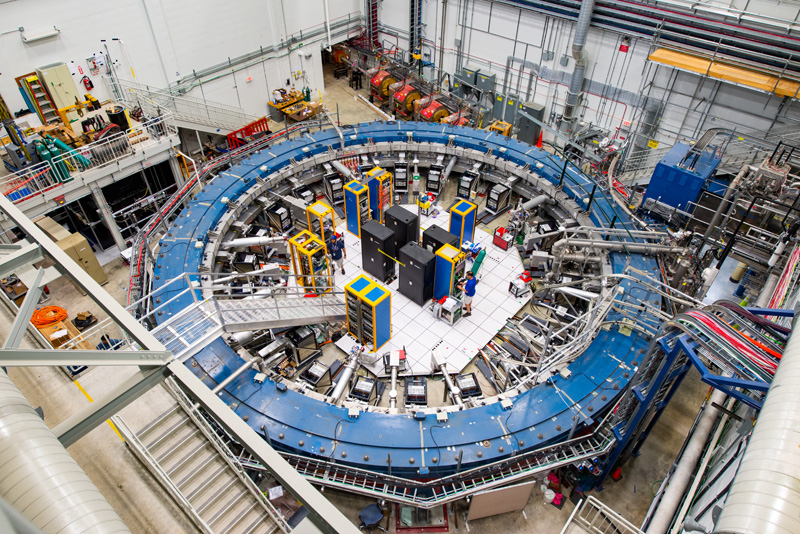 |
The anomalous magnetic moment of the muon was previously measured in 2004 to a precision of 540 parts per billion (ppb) by the E821 Muon g-2 Experiment at Brookhaven National Laboratory (BNL). The Fermilab Muon g-2 Experiment (E989) has confirmed and strengthened this result with measurements to precisions of 463 ppb (2021), 214 ppb (2023), and 139 ppb (2025), all in excellent agreement with the BNL measurement. These provide a stringent test of the Standard Model by comparing with the theory-predicted muon anomaly. The Muon g-2 Theory Initiative (https://muon-gm2-theory.illinois.edu/) released a recommended Standard Model value in 2020 (arXiv:2006.04822) which was in tension with the experimentally measured muon anomaly, with the hadronic vacuum polarization contribution determined from a data-driven dispersion approach. Significant tensions have since emerged in the experimental inputs for this approach. In 2025 they updated the recommendation (arXiv:2505.21476) to instead use a lattice QCD determination of this contribution, and this latest recommended value is in agreement with the experimental muon anomaly. The Fermilab Muon g-2 experiment’s ultimate goal is to improve on the precision of the BNL measurement by a factor of 4, and thus to provide a robust benchmark for future Standard Model and Beyond-Standard-Model theory values. The group at UW was heavily involved in forming the new collaboration (with Prof. Hertzog serving as co-spokesperson) -- helping to relocate the ring magnet from Brookhaven National Laboratory to Fermilab, designing beamline strategies, and prototyping new detectors. Since then, we have been one of the largest groups within the collaboration, contributing to each aspect of the measurement. In particular the UW group has:
as well as many more ongoing contributions. Results from Run-1 of the Muon g-2 Experiment were published in 2021, generating worldwide excitement in popular and scientific news, and Run-2/3 results were published in 2023. The experiment finished collecting data with Run-6 in 2023, exceeding the statistics goal of 21 times BNL data. Final results from Run-4/5/6, the largest dataset, released in June 2025 reinforced the previous results and brought the world average experimental value to a precision of 124 ppb. Image Credit: Fermilab. |
||
| TWiki | Webpage | PSI - Villigen, Switzerland | |
|
|
MuSun (Kammel co-spokesperson) will measure muon capture on the deuteron, the simplest weak interaction process on a nucleus that can both be calculated and measured with high precision. Modern QCD-based theories relate capture to one of the most important nuclear reactions of the universe—weak pp capture—which is the main source of energy in the Sun. It is also related to the ν+d reactions detected by the Sudbury Neutrino Observatory with significant participation of CENPA. To the required precision, these reactions depend on a single parameter, which characterizes poorly known aspects of the two-nucleon axial current. MuSun will be the first precision measurement of this constant in the 2N sector and will help to calibrate the basic astrophysics reactions. The technique is unique, as it relies on a cryogenic time-projection-chamber, with critical developments in our UW laboratories. |
||
| PSI - Villigen, Switzerland | |
|
|
Recently, work has begun on a next generation experiment to measure the charged-pion branching ratio to electrons vs. muons. This measurement, which is highly sensitive to new physics at high mass scales, has broad implications for the universality of lepton interactions. Using state-of-the-art instrumentation - learning from the previous generation PEN and PiENu measurements - and a new high-intensity beam, measurements of the pion decay to electrons vs. muons and pion beta decay will improve on previous studies by an order of magnitude to the 10-4 precision level. A disagreement with the theoretical Standard Model(SM) prediction, which has a remarkable precision at the same level, would unambiguously imply new physics beyond the SM. Exotic rare decays involving sterile neutrinos and axions will also be searched for with unprecedented sensitivity.
The PIONEER experiment proposal was submitted to the Paul Scherrer Institute and approved in 2022. To drive the development of this next generation pion decay experiment, the muon group took the lead on the simulation and analysis efforts by using the local computing cluster. Informed by these simulations, the detector design consists of an active target to stop the pion beam surrounded by a 19 radiation length calorimeter. We are thoroughly investigating the option to use LYSO crystals for the calorimeter and tested a first prototype at PSI in 2023 (arxiv, article). Using the Van-de-Graaff accelerator at CENPA, we are hosting test beam projects for the development of LGAD sensors to be used in the active target. |
Completed efforts
| PSI - Villigen, Switzerland | |||
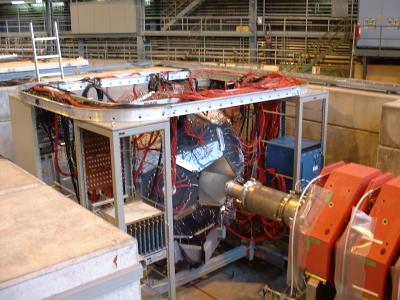 |
The Muon Lifetime Analysis (MuLan) experiment (Hertzog co-spokesperson) recently completed a measurement of the positive muon lifetime to a precision of 1.0 ppm (part per million), the most precise particle lifetime ever measured. The muon lifetime provides the most precise determination of the Fermi coupling constant, which is one of the fundamental inputs to the Standard Model. Recent advances in theory have reduced the theoretical uncertainty on the Fermi coupling constant as calculated from the muon lifetime to a few tenths of a ppm. The remaining uncertainty on the Fermi constant is entirely experimental, and is dominated by the uncertainty on the muon lifetime. The MuLan experiment used an innovative pulsed beam, a symmetric detector, and modern data-taking methods to obtain more than 2x1012 events. The result has been published in PRL: http://prl.aps.org/abstract/PRL/v106/i4/e041803. | ||
| TWiki | Webpage | PSI - Villigen, Switzerland | |
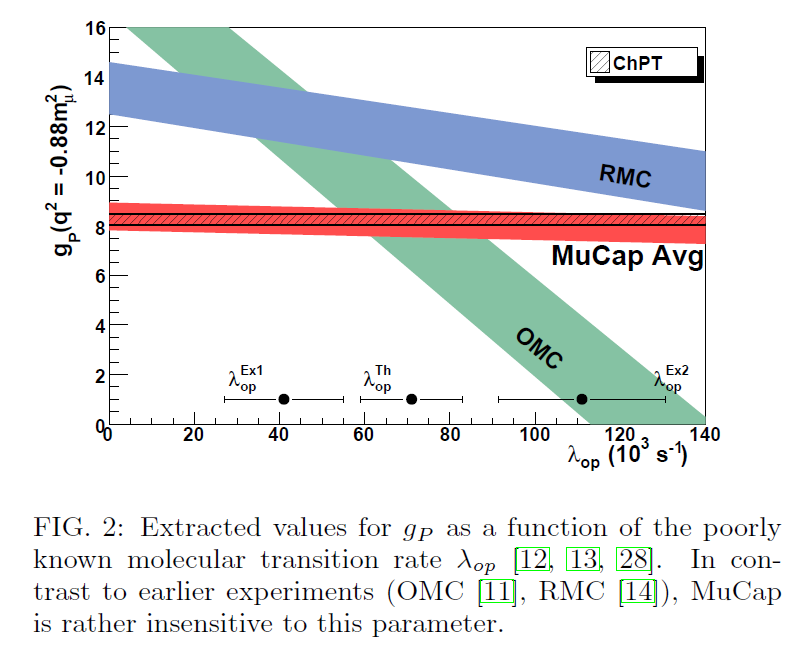 |
The µCap experiment (Kammel co-spokesperson) was a 1% precision measurement of the muon capture rate on the proton. From the capture rate the pseudoscalar form factor gP of the nucleon was extracted with 7% precision. This basic quantity is predicted theoretically with high precision, but the experimental situation was quite controversial. The experiments were based on a novel method utilizing a time-projection-chamber filled with ultrapure pressurized hydrogen gas. This technique eliminates many uncertainies plaguing earlier experiments. The result was an unambiguous value for gP and a sensitive test of the chiral symmetry of QCD at low energies. Check out the latest result on the arXiv: http://arxiv.org/abs/1210.6545 | ||

